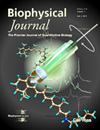Predicting red blood cell transport and capillary hemodynamics in angiogenic and tumor vascular networks in silico.
IF 3.1
3区 生物学
Q2 BIOPHYSICS
引用次数: 0
Abstract
Blood flow through capillary vessels in cancerous tissue plays a crucial role in disease progression and treatment. Unlike the microvasculature in healthy tissue, which is hierarchically well-organized, a cancerous tissue is characterized by chaotic organization. A detailed quantification of blood cell transport and capillary hemodynamics in tumor microvasculature is lacking. Specifically, the relationship between tumor vascular geometric abnormalities, the dynamics of flowing blood cells, and the resulting blood flow anomalies at the vasculature scale is unknown. To fill this knowledge gap, we utilize a high-fidelity computational model of flow of a deformable red blood cell (RBC) suspension through angiogenic and tumor microvasculatures in silico built from in vivo/ex vivo images. We provide detailed quantitative distinctions between the healthy, angiogenic, and tumor microcirculation by predicting hemodynamic parameters that are difficult to experimentally measure but physiologically significant. These include the shape and dynamics of individual RBCs, the Fahraeus effect, blood viscosity, wall shear stress, and a 3D mapping of the RBC-depleted region near the vascular surface. This study opens a new avenue for studying tumor microcirculation using high-fidelity computational modeling in revealing novel microcirculatory phenomena in silico.预测血管生成和肿瘤血管网络中的红细胞运输和毛细血管血流动力学。
癌组织中毛细血管的血流在疾病进展和治疗中起着至关重要的作用。与健康组织的微血管不同,健康组织的微血管在层次上组织良好,癌组织的特点是组织混乱。目前缺乏对肿瘤微血管中血细胞运输和毛细血管血流动力学的详细定量研究。具体而言,肿瘤血管几何异常、血流细胞动力学以及由此产生的血管尺度血流异常之间的关系尚不清楚。为了填补这一知识空白,我们利用基于体内/离体图像构建的可变形红细胞(RBC)悬浮液通过血管生成和肿瘤微血管的高保真计算模型。我们通过预测血液动力学参数提供了健康微循环、血管生成微循环和肿瘤微循环之间的详细定量区分,这些参数在实验上很难测量,但在生理上具有重要意义。这些包括单个红细胞的形状和动力学、法氏效应、血液粘度、壁剪切应力和血管表面附近红细胞耗尽区域的3D映射。本研究为利用高保真计算模型研究肿瘤微循环开辟了一条新的途径,揭示了新的微循环现象。
本文章由计算机程序翻译,如有差异,请以英文原文为准。
求助全文
约1分钟内获得全文
求助全文
来源期刊

Biophysical journal
生物-生物物理
CiteScore
6.10
自引率
5.90%
发文量
3090
审稿时长
2 months
期刊介绍:
BJ publishes original articles, letters, and perspectives on important problems in modern biophysics. The papers should be written so as to be of interest to a broad community of biophysicists. BJ welcomes experimental studies that employ quantitative physical approaches for the study of biological systems, including or spanning scales from molecule to whole organism. Experimental studies of a purely descriptive or phenomenological nature, with no theoretical or mechanistic underpinning, are not appropriate for publication in BJ. Theoretical studies should offer new insights into the understanding ofexperimental results or suggest new experimentally testable hypotheses. Articles reporting significant methodological or technological advances, which have potential to open new areas of biophysical investigation, are also suitable for publication in BJ. Papers describing improvements in accuracy or speed of existing methods or extra detail within methods described previously are not suitable for BJ.
 求助内容:
求助内容: 应助结果提醒方式:
应助结果提醒方式:


